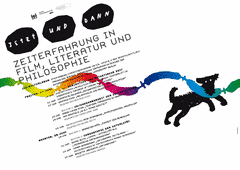Learn more
- Jul 8, 2008
Semantics and Universal Metaphors of Time

What is news? What impact does news have on people? What about time? One of the most enigmatic aspects of experience concerns time. Since pre-Socratic times, scholars have speculated about the nature of time, asking questions such as: What is time? Where does it come from? Where does it go? What is its structure?
„In many respects aesthetic experience is bound to time: the time of reading, the rhythm of a filmic montage, the temporal construction of a story. Without such temporal markers as these, aesthetic experience would neither be comprehensible nor would it even be possible. Poetological and philosophical reflection on the temporal basis of aesthetic experience give shape to… questions as… addressing the subjectivity of temporal experience through aesthetic form… how temporality and causality leave their mark in experience… how to treat „actuality“ as an aesthetically significant topos of Modernity“ and more. [Source]
It was not astonishing to me that I found a book called Semantics and Experience: Universal Metaphors of Time in English, Mandarin, Hindi and Sesotho (Parallax: Re-visions of Culture and Society). The author Hoyt Alverson says that people everywhere experience time in fundamentally similar ways. Alverson begins by studying time expressions in collocations – stock phrases, idioms, aphorism, or other formulaic expressions.
Are there universal as well as culturally particular experiences and expressions of “time”? In “Semantics and Experience”, Alverson questions the widely held anthropological assumption that temporal expression and experience represent little more than local cultural constructions. Drawing on extensive data from four widely divergent languages and cultures – English, Mandarin, Hindi and Sesotho – he argues that people everywhere experience time in fundamentally similar ways. Alverson examines the metaphors that often compose these collocations and discovers that five basic, universal categories of temporal expression and experience appear in all four languages – despite the independence of these languages from one another and despite the differing conditions of belief, knowledge and institutional structure among their respective cultures. While metaphorically constituted collocations do reflect culturally particular features of ideology, Alverson concludes, they clearly reflect universals of “time” as well. “Semantics and Experience” offers linguistic analysis of time expressions in four radically different languages and cultures. It reveals not only how such expressions vary as a function of ideological and cultural differences but also how, despite these differences, they reveal a basic similarity that points to their origin in a pan-human approach to the construction and cognition of space. [Source]
The book which is currently out of print was written in 1994. Obsolete? Not at all, that I am confident of. The most significant metaphor of Semantics to my mind is understanding, comprehending, appreciating one another. This might sound wordly-innocent but I´m sure it´s the future of living together and should somehow relativize many concepts of ivory towers. There will always be differences, stakeholders, communities. This is essential and healthful. All the more it needs comprehension.
So what about Semantic Web? Where is the context here? Hoping to hear that from all of you – every now and then 😉
Marion.
